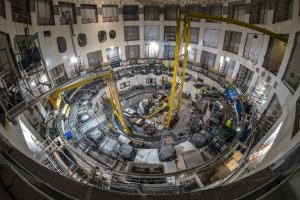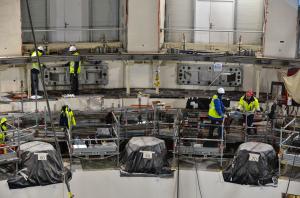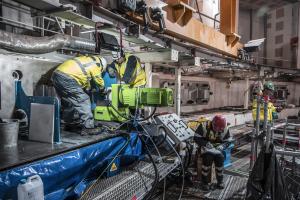Grand opening soon
Picture a giant soup plate, 30 metres in diameter, slowing descending into a deep concrete cylinder. Track the near imperceptible movement of the double overhead bridge crane, as it moves a few millimetres at a time to align the plate's rim with prepared supports 60 metres below. Feel the tension as the operation unfolds and the 1,250-tonne steel component eventually settles with submillimetre precision on the massive concrete "crown" waiting below. And mark your calendars, because what you have just visualized will be the opening act of ITER machine assembly this spring—the insertion of the cryostat base into the tokamak pit.
The cryostat base, part of the insulating vessel that encases the ITER tokamak, is the heaviest of all the machine components. As the first of four cryostat sections to be lowered into the Tokamak pit, it must be aligned with utmost precision as any departure from its nominal positioning would affect the entire structure of the 30-metre-tall cryostat.
The concrete "crown" upon which the cryostat base will ultimately rest is equipped with different types of supports, whose function is to maintain the component in place while accommodating the movement caused by the tremendous forces at work in the machine. As a consequence, the support system needs to be both extremely robust, with a strong connection to the Tokamak Complex basemat and bioshield walls, and yet flexible enough to allow some "breathing space" for to the colossal mass of the tokamak enclosed in its insulating cryostat (23,000 tonnes).
However careful the controls and measurements performed throughout the manufacturing process, the "as built" reality of a component (especially one as large as the cryostat base) always presents some degree of deviation from its reference design. At the points of interface between the component and its supports, it is absolutely crucial to compensate for these minute variations.




